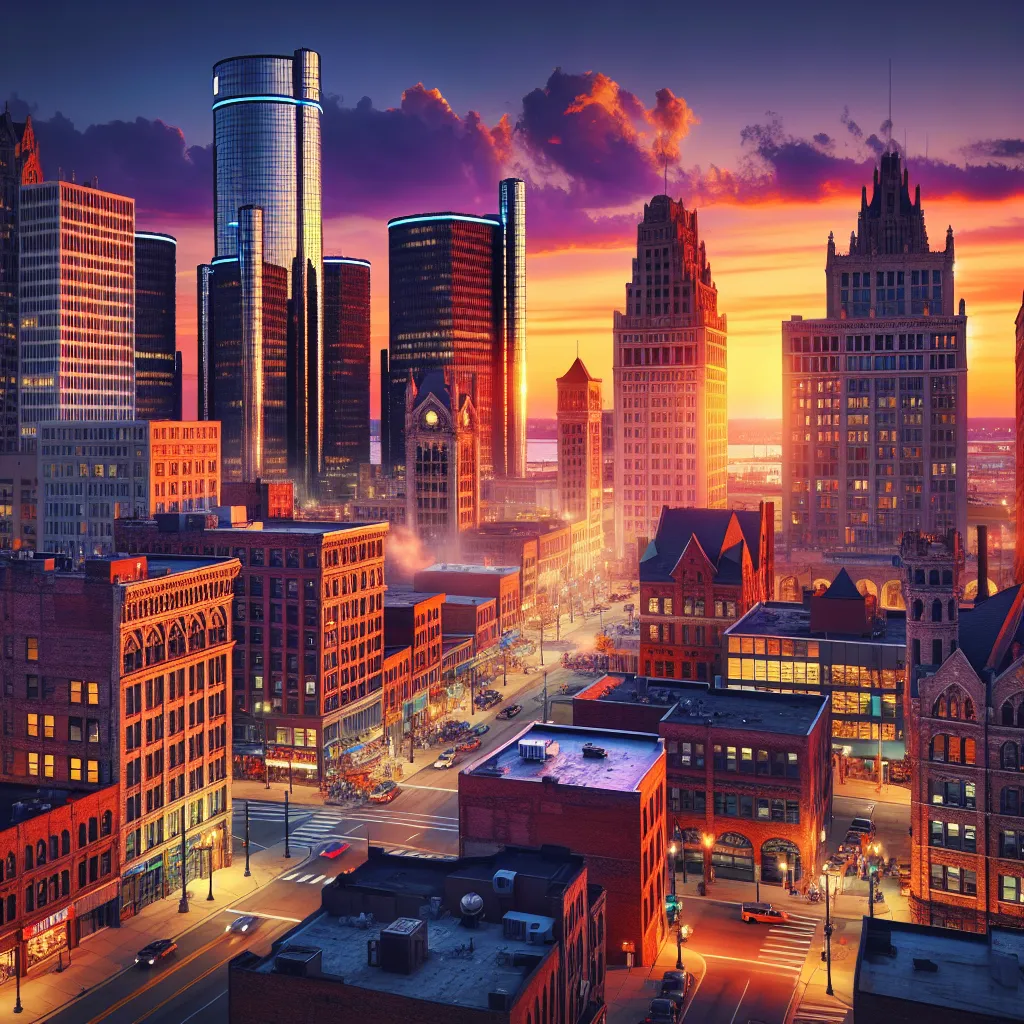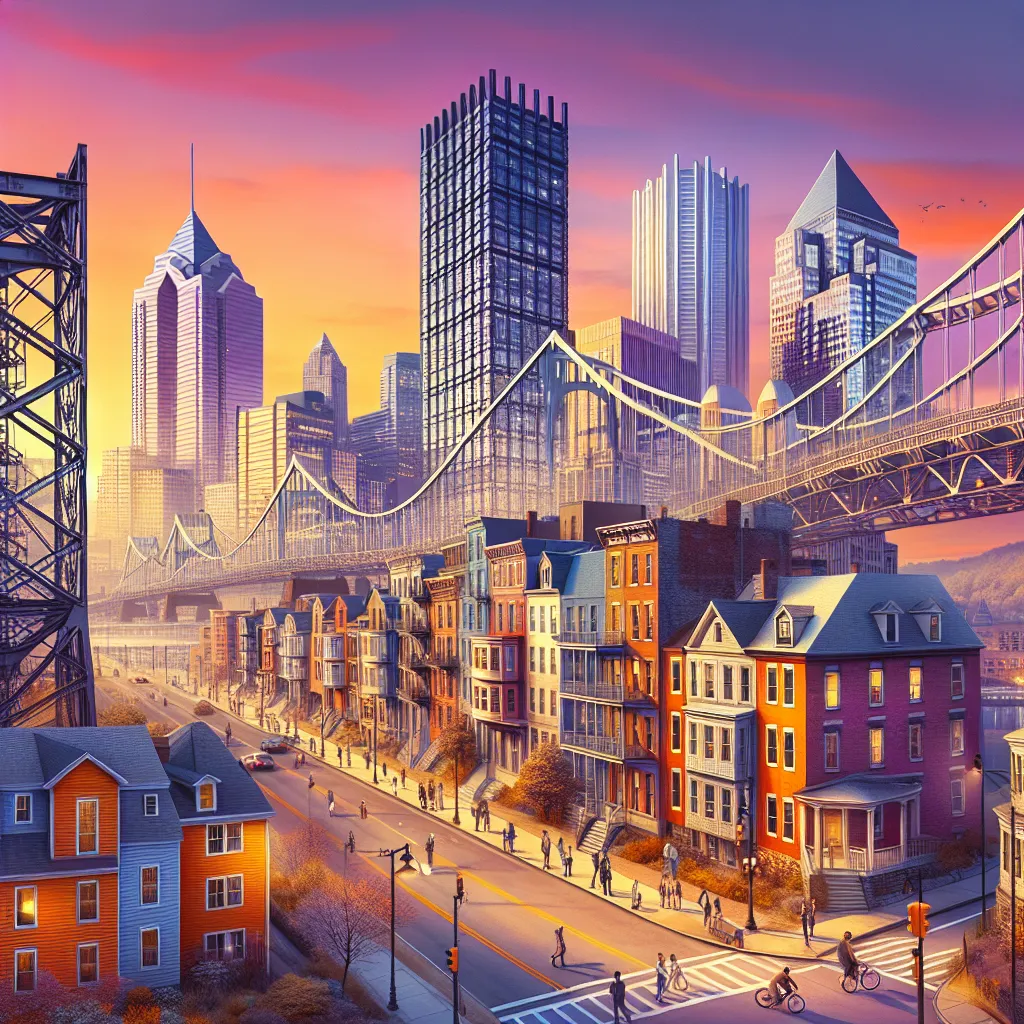Detroit, Cleveland, and Pittsburgh: How have these American cities changed?

- Detroit and Cleveland: how the cities are overcoming challenges and developing?
- Modern Architecture and the Real Estate Market in Cleveland and Pittsburgh
- How did St. Louis and Cincinnati change in the 20th century?
Detroit: History and Modernity
In Detroit, Michigan, the population is around 600,000, and when considering the entire metropolitan area, the total number of residents reaches 1.7 million. Once, Detroit was an icon of the U.S. automotive industry, but by the end of the 20th century, the economic and infrastructure situation in the city began to decline, and in 2013, it was forced to declare bankruptcy.
But starting in 2014, a recovery program was launched that helped Detroit begin a new phase of its development. Currently, large companies such as the following are located in the city and its surroundings:
- General Motors
- Ford Motor
- Chrysler
- Deloitte
- Kellogg's
- Whirlpool
This has a positive effect on the labor market, creating a stable demand for housing in the region. However, since the 1950s, the population of Detroit has continued to decline. While the city had a population of 1.8 million people at that time, this figure has now decreased by more than three times.
In addition, in the last decades of the 20th century, the city gained a bad reputation due to high crime rates. Although currently, thanks to the efforts of local authorities, the crime rate has decreased somewhat, Detroit still ranks alongside another city marked by high crime – St. Louis.
Real estate in Detroit
Although the city has an extensive housing stock, a significant number of buildings remain unused, which, along with its troubled reputation, makes Detroit one of the most economically affordable cities to live in the U.S.
As for real estate prices, as of September 2021, the median sale price of homes in Detroit was $164,600, with an annual growth rate of 15%. In some neighborhoods of the city, you could buy a house for as little as $46,000!
Cleveland: changes and development
Cleveland, located in Ohio, is the second largest city in its state with a population of about 400,000 people, and when including the suburbs, this number reaches 1.8 million. The development of Cleveland began in the late 19th century and continued until the mid-20th century, when the city was home to major companies like the former famous Standard Oil.
However, over the past seven decades, Cleveland's population has more than halved: while there were once over 900,000 residents, that number is now much lower, as many middle-class individuals choose to live in quieter suburbs.
Economy and transportation in Cleveland
Today, Cleveland's industrial production no longer holds a leading position, having given way to other sectors such as healthcare, education, and finance. Nevertheless, Cleveland still remains an important transportation hub due to its strategic location.
The city is located on the shores of Lake Erie and near the border with Canada, which provides it access to the Atlantic Ocean.
The history and architecture of Cleveland
In the early 20th century, the historic center of Cleveland was built, which is considered one of the best examples of the "city of beauty" concept. Today, this place perfectly combines elements of both historical architecture and modern engineering solutions.
This is bound to attract both locals and tourists. This city demonstrates how to cope with difficult situations and find new opportunities for growth and progress.
Architectural Trends
Supporters of new architectural movements sought to bring to life harmonious and attractive structures that would contrast with the gray industrial landscapes and mass skyscrapers. Nowadays, within major cities, one can see several grandiose buildings that exceed a height of 200 meters. In recent decades, many industrial areas have been integrated into the urban structure, and some of them are beginning to attract affluent Americans once again.
Real Estate Prices in Cleveland
As for the real estate market, the median home price in the Cleveland metropolitan area is approximately $175,000. Over the past year, home prices have increased by 12%. If you are interested in current events in the areas...investments,immigrationorforeign real estateIt is recommended to subscribe to special channels.
Overview of Pittsburgh
Now let's discuss Pittsburgh, Pennsylvania. This city is the second largest in its state, with a population of about 300,000, and the metropolitan area has a population of approximately 2.3 million. Since the early 1950s, there has been a sharp decline in population, and over the last decades of the last century, it decreased by more than half, but currently, the rate of population decline has significantly slowed down. The population in this region has stabilized.
Historical Heritage
Pittsburgh, embodying one of the largest industrial centers of the 20th century, is renowned for its steel mills that closed down in the 1970s and 1980s. Today, this city has become known as an important scientific and cultural hub:
- Here are the universities that are among the best educational institutions in the USA.
- Pittsburgh is also proud of its famous museums.
- The city is actively developing medical technologies and high-tech industries, becoming home to offices of companies like Google, Apple, Bosch, Facebook, and Amazon.
Pittsburgh downtown
In the heart of Pittsburgh, where the rivers converge, lies the so-called "Golden Triangle," home to a famous row of thirty skyscrapers. On the northern side, you can see buildings that were constructed as far back as the 19th century. The southern part of the city, which was once the center of industry and the site of affordable housing for workers, has undergone significant changes in recent decades, transforming into a rapidly developing area with an annual increase in real estate prices.
In 2021, the average housing price in the Pittsburgh area was about $200,000, and it increased by 16% over the year.
A trip to St. Louis
Now let's discuss St. Louis, Missouri.
29 September 2025
29 January 2025
9 October 2024
9 October 2024
29 January 2025

Cultural Heritage
St. Louis carefully preserves its Native American heritage and remembers its French colonial period. The development of steamboat transportation on the Mississippi and Missouri rivers in the 19th century became an important factor for the city's economic growth, leaving a significant mark on its history and culture.

Transformations of the city in the 20th century
The 20th century turned out to be a time of significant changes for the city, which experienced both industrialization and a massive influx of African Americans from rural areas in the second half of the century. At the beginning of its existence, the city could not be called prosperous: a hundred years ago, St. Louis had some of the most polluted air in the United States, due to the heavy use of coal.
Environmental issues
Environmental issues began to be addressed only in the mid-20th century. With the transition to the new century, gentrification processes started to occur in certain areas. These transformations led to St. Louis being awarded the "World Leadership" award for urban renewal in 2006.
Demographic changes and security
Nevertheless, despite this, the population continues to decline, and St. Louis remains one of the most unsafe cities in America, although the crime rate in the city has been decreasing since the 1990s.
The real estate market in St. Louis
As for the real estate market, in 2021 the median home price in the greater St. Louis area was215 thousand dollarsHowever, in the city itself, in some areas, average prices reached up to800 thousand dollarsOne of the most expensive areas is the Ladieu district, known for its top educational institutions. Throughout the year, housing prices have increased by17%.
Cincinnati: History and Development
Cincinnati in Ohio is the third largest city in the state, with a population of about300,000The population, along with the suburbs, reaches almost2 million peopleThis city began to actively develop in the early 19th century when transportation routes were established along the Ohio River. At that time, Cincinnati was among the ten largest cities in the country.
Transport and architecture
By the end of the century, rail transport had become the main mode of transportation, which led to the city losing its strategic importance. During these decades, Cincinnati developed a solid historical architecture that still attracts many tourists today.
Economic changes after the war
Like many old industrial cities in the U.S., Cincinnati faced harsh economic changes after World War II. However, the decline in population was not as dramatic — with500 thousandto300,000Over the past ten years, Cincinnati has even shown an increase in its population.
Economics and startups
This city is home to the main offices and factories of companies such as Procter & Gamble, Kroger, General Electric, Macy's, Toyota North America, and others. The city has become known as“startup center”The University of Cincinnati ranks second among employers in the region.
Housing prices in Cincinnati
When it comes to housing prices, the median price for purchasing real estate in Greater Cincinnati was218 thousand dollarsthe annual price growth reached18%These indicators, combined with the promising growth prospects of the city, make real estate acquisition a very attractive investment.
Real estate in the USA at low prices
When it comes to buying housing in the US at lower prices, it's important to note that this is not New York. Research data confirms that the cheapest real estate markets in Florida offer great deals for purchase. At the same time, on the other end of the price spectrum are the cities in California:
- San Francisco - the average housing price is1.45 million dollars
- San Jose —1.192 million dollars
- Auckland —830 thousand dollars
- Anaheim —781 thousand dollars
Prospects for the revival of post-industrial cities
As I came to the conclusion while considering the situation in Detroit, Cleveland, Pittsburgh, and St. Louis, it is that each of these cities, despite their ups and downs, still has immense potential for revival and economic growth.
The stages of decline that these cities experienced, especially in the last decades of the 20th century, were tough for the residents and had a significant impact on their demographic structure. However, over time, these post-industrial cities began to find new niches and opportunities.
Detroit: A Return to Life
In particular,DetroitSlowly but surely, it is coming back to life thanks to new investments and startups that are interested in its cultural heritage and economic potential.
Cleveland: from industrial scale to medicine
Clevelandsuccessfully transformed from an industrial center into an important hub for medicine and finance.
Pittsburgh: a leader in technology
PittsburghWith its history of steel mills, it is now at the forefront of high technology and medicine, attracting leading companies.
St. Louis: a rich heritage
St. Louis, with its rich historical heritage, continues to be home to many cultural and industrial initiatives.
Advantages and challenges
These cities, despite their problems, are becoming increasingly attractive to new residents and investors. They offer affordable housing prices and excellent opportunities for work and education.
- Affordable real estate prices;
- New jobs and startups;
- Cultural initiatives and educational institutions.
Conclusion: A Look into the Future
Of course, challenges remain — crime, infrastructure decline, and the need for innovative approaches to economic growth. Nevertheless, I am confident that with the right approach and support from local authorities, these cities:
- They will not only be able to recover,
- But also to become groundbreaking in new areas such as technology and sustainable development.
That’s why I recommend paying attention to potential investments in these regions, where a rich past is gaining new life in the modern world.
Tags
Comment
Popular Posts
29 September 2025
393
9 October 2024
9942
9 October 2024
1487
29 January 2025
1530
Popular Offers

Subscribe to the newsletter from Hatamatata.com!
Subscribe to the newsletter from Hatamatata.com!
I agree to the processing of personal data and confidentiality rules of Hatamatata











